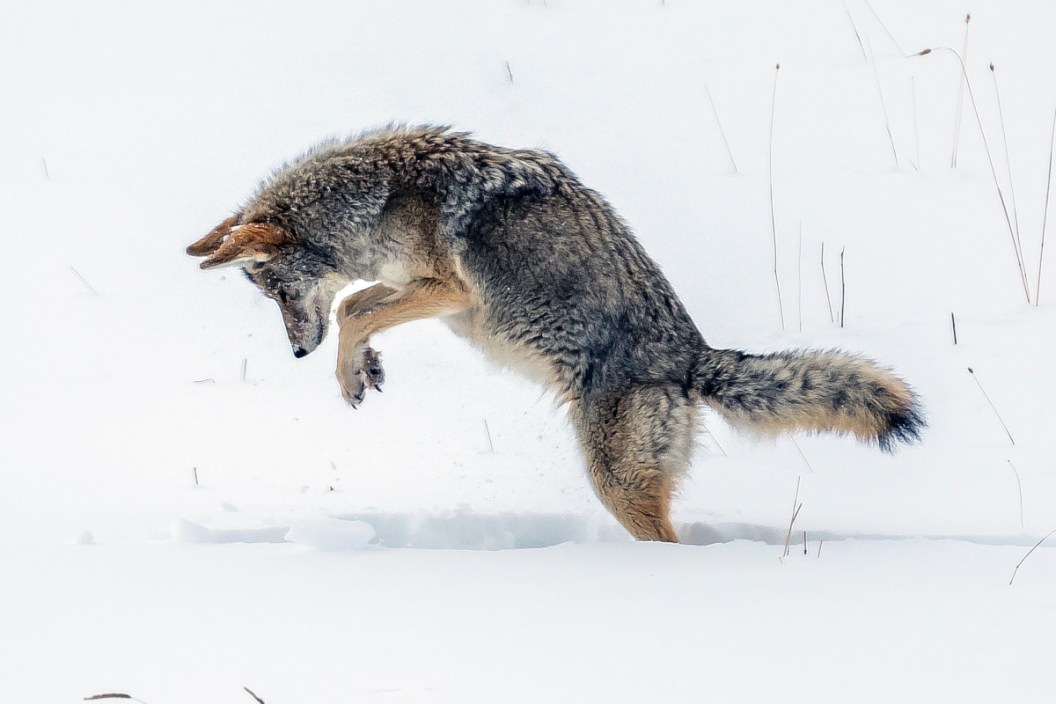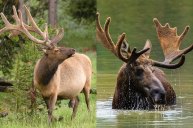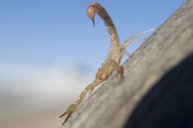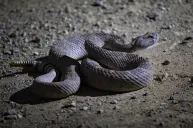Opportunistic scavengers and aggressive predators that seize pretty much any opportunity for a meal: That's the general reputation of the wild North American coyote. And it's spot on.
These furry, sharp-teethed mammals are becoming more conditioned to humans, with coyote sightings in cities and suburban backyards—which means they are more frequently feasting on human trash. A 2020 study out of California analyzed the scat of "urban coyotes" in Los Angeles and found evidence of the animals having eaten everything from corn-based processed food to food wrappers.
What Do Coyotes Eat?
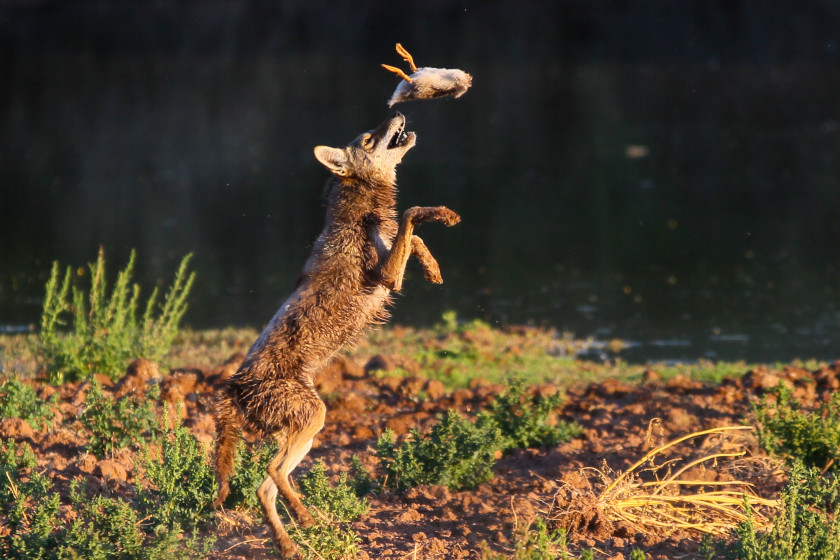
Getty Images, FastGlassPhotos
Canis latrans—better known as the common coyote—is a shifty, cunning, ruthless, opportunistic feeder that will eat just about anything it can catch or scavenge. While most people may think of these members of the dog family as being strictly carnivores, they are, in fact, omnivores, dining on small animals and big game alike, as well as plants, insects, fruits, berries, and garbage.
The bulk of the coyote's diet is made up of small mammals such as mice, moles, rats, squirrels, chipmunks, prairie dogs, raccoons, and other small rodents. However, they'll enjoy rabbits, birds, amphibians, snakes, and fish when they can catch them. Coyotes are also well-documented scavengers. They will not turn their noses up at carrion (a.k.a. the decaying meat of carcasses) when they can find it or steal it from another predator.
Coyotes' Main Meat Meals
When hunting solo, a typical meal usually consists of some type of small prey. When they hunt in packs, coyotes have been known to target larger prey, including wild turkeys, full-grown deer, cow elk, pronghorn, and wild sheep. This is often where they begin to catch the ire of dedicated hunters.
Coyotes are particularly effective in killing and eating young, more helpless animals, such as fawns. As with any wild predatory animal, coyote populations hinge on their food sources, and when their target animals are plentiful, there will be a lot of coyotes in the area. In years that see more fawns born in the spring, female coyotes will often have correspondingly larger litters.
Coyotes' Favorite Side Dishes
As omnivores, coyotes consume fruits, vegetables, leaves, and roots, too. They won't think twice about eating easily accessible human garbage, pet food, and other discarded items. Coyotes have also been documented as being able to digest grains, greens, and domestic animal droppings. These are obviously less common items in their diet, but a hungry coyote is rarely picky about what it will eat.
And all of these facts make sense when we consider the urban coyote that lives in cities instead of the wilderness and eats human food. This is so common, in fact, that the aforementioned 2020 California study reported roughly 38 percent of the coyotes studied ate human leftovers, as well as "ornamental fruits" (ficus, loquat, grapes, and palm tree fruit).
Where Do Coyotes Live?
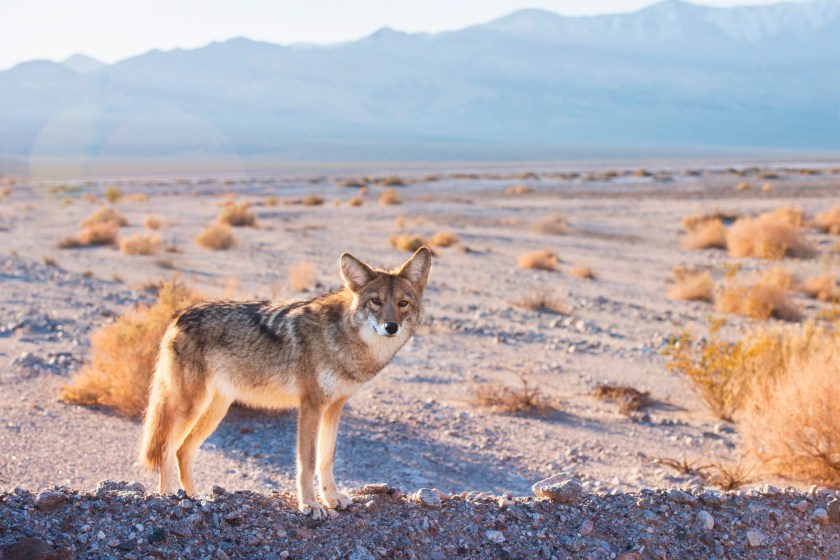
Getty Images, Boogich
With their home range covering much of North America, these canids are found just about anywhere. Coyote populations are found around the United States and Canada, dwelling in the deep wilderness, well-populated urban areas, and everywhere in between. Their subspecies have stretched all the way from Alaska to Central America.
They can thrive in arid desert areas, vast grasslands, mountain ranges, and hardwood forests. They have more recently become a problem in urban areas such as New York, Chicago, or Los Angeles. As sightings of the bushy-tail creatures in cities continue to rise, it has many people concerned about small dogs and children who may be targeted by them.
How Big Are Coyotes and What Do They Look Like?
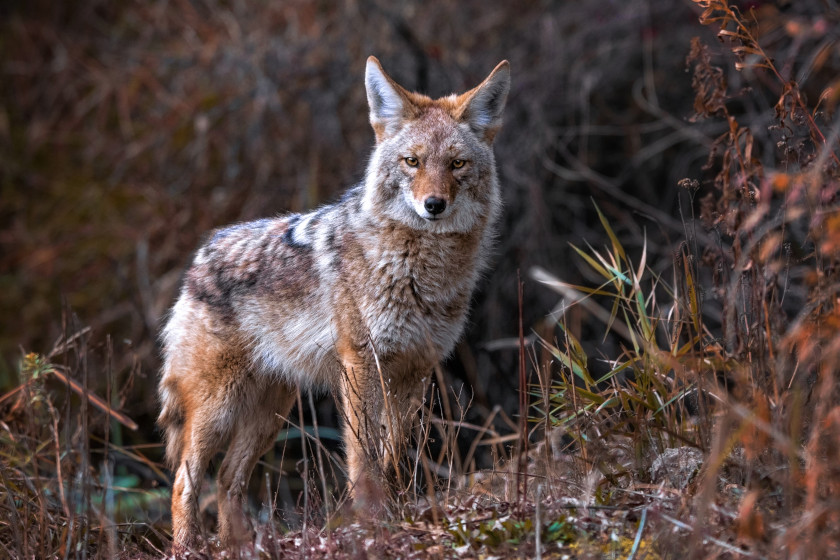
Getty Images, graphicphoto
Coyotes can vary greatly in size. These canids are smaller than their close relatives, the gray wolf, and slightly smaller than the closely related eastern wolf and the red wolf. Most weigh somewhere in the 15- to 45-pound range. Every so often, a rare specimen may weigh over 50 pounds. They measure anywhere from 30 to 40 inches in length, quite a bit smaller than the gray wolf.
Their black-colored noses are usually less than 1 inch in diameter. They have large ears in relation to the head, slightly long legs, and relatively small feet.
The coloration of coyotes can vary—even within the same region—from grayish brown to a yellowish gray around the shoulders and upper back. The throat and belly are usually a whitish color. The legs and feet, sides of the head, and muzzle can be brown to reddish brown.
What Does a Coyote Sound Like?
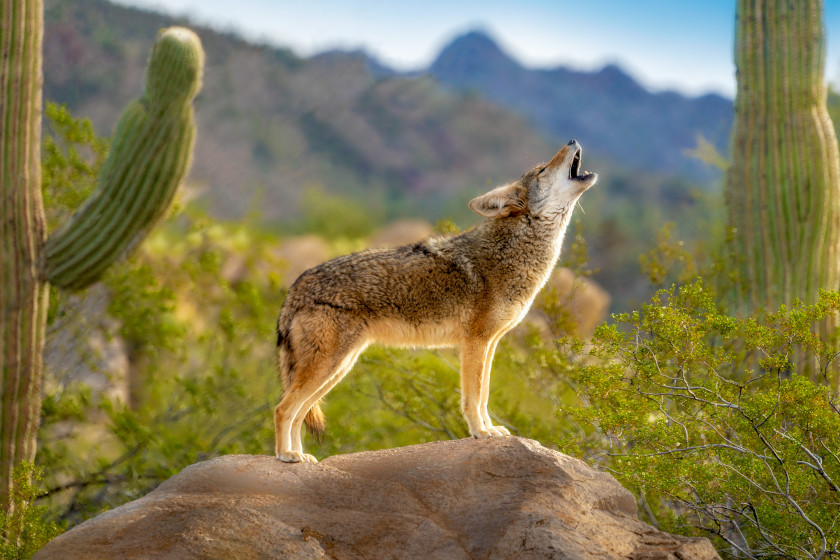
Getty Images, Jay Pierstorff
Coyotes are the most vocal of all the North American wild mammals. While coyotes use three distinct vocalizations—the squeak, the distress call, and the howl—it is this last of these that most humans have heard before. Howling serves several purposes, most often to simply announce their presence to other members of the pack. It's also used as a territorial warning to other packs, and sometimes as an assembly call.
Coyotes are generally active at night, although it's not all that unusual to see them during the daylight hours. It's usually after dark when their chorus of howls begins, and sometimes it can be quite unnerving for those who aren't used to it. Coyotes don't form packs to the same extent as wolves; but when you start to hear them howling and moving in high numbers, it's likely a pack or family group of some kind, and likely hunting together.
Will Coyotes Hurt Humans?
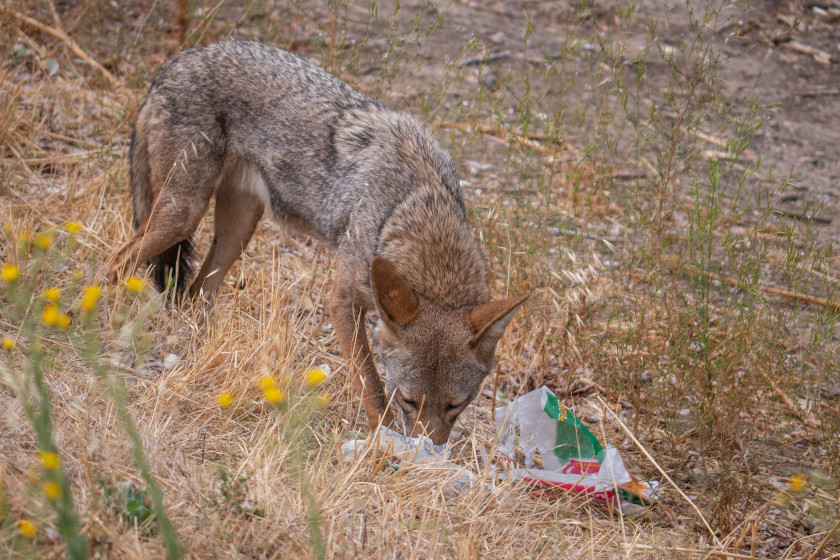
Getty Images, Eric Buell
While coyote attacks on humans are rare, they do happen. Most cases involve small children in urban settings where the coyote is an unexpected intruder. You're highly unlikely to be attacked or killed by one.
If you ever encounter a coyote, keep your distance. Stand tall, maintain eye contact, and do not turn your back. Even more importantly, do not run away, as that can trigger a chase-and-attack response—and you're instantly at a disadvantage. As the Urban Coyote Initiative suggests, permanently scaring them away is the main objective. For additional safety, always keep pets on a leash, keep control of them, and avoid known coyote areas, especially after dark.
In general, the best thing is to coexist. Coyotes can be beneficial, because they keep down the numbers of rabbits and rodents that can overrun an area without check. But they also host many diseases such as rabies, and they are often seen with mange.
As mentioned, the coyote is not a picky eater. They will eat whatever meal is the easiest to obtain. Much of their diet is made up of small game, such as rabbit, hare, squirrel, and the like, but they also eat plenty of larger game such as whitetail deer. A favorite of coyotes is fawn, meaning baby deer. In addition to meat, coyotes will eat berries, fruits, insects, and even trash. As ruthless and opportunistic predators, coyotes will prey on family pets, including cats and small dogs. Those who live in known coyote country should supervise off-leash pets while outside. Many people think that coyotes are nocturnal and sleep during the day. But actually, coyotes are naturally diurnal, meaning they're active during the day. Coyotes require food every day. To fulfill this need, they hunt while their prey is active, which can mean during both daylight and nighttime hours.All Your Questions About Coyotes, Answered
